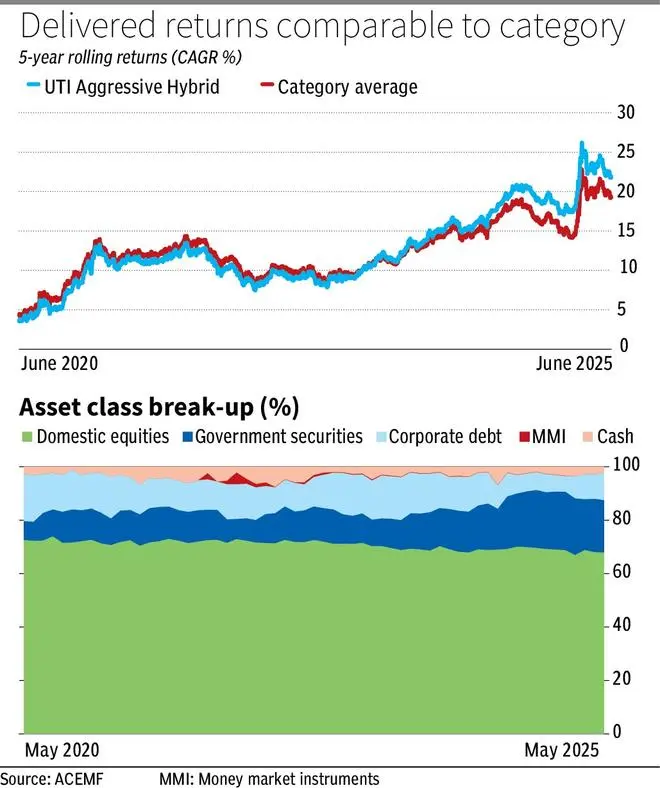

Aggressive hybrid mutual funds aim to balance growth and stability by investing 65–80 per cent of their portfolio in equities and 20–35 per cent in debt instruments. This asset mix makes them suitable for investors with a low-to-moderate risk appetite. However, individual schemes within this category can sometimes take on higher risks on their equity or debt exposures.
UTI Aggressive Hybrid Fund leans the other way. It distinguishes itself with a pronounced tilt toward value investing within its equity allocation. This approach focuses on companies with strong fundamentals that are undervalued by the market, banking on the idea that their intrinsic worth will eventually be recognised. Such a strategy, however, requires investor patience, as the fund may lag behind those following growth or momentum strategies.
The fund is suited for long-term investors who can stay through stretches of underperformance. It is not ideal for investors who become anxious during extended stretches of mediocre returns.
Over the last 10 years, the fund delivered returns below the category average about 60 per cent of the time, as the growth style took centre stage and outperformed value in the first half of the decade. Nevertheless, the fund’s disciplined value approach has rewarded patient investors, delivering a 10-year compounded annual return of 12.3 per cent, surpassing the category average of 11.7 per cent.
UTI Aggressive Hybrid fund follows a static allocation approach, typically maintaining an equity allocation of 70–72 per cent. The remaining portion is invested in debt (approximately 23–25 per cent), with around 2 per cent held in cash. On the equity side, the fund operates like a flexi-cap fund, currently allocating roughly two-thirds to large-cap stocks (an average of 48 per cent of total assets over the last five years), with the remaining portion split between mid- and small-cap stocks.
The fund’s investment style is based on a relative value approach, prioritising companies trading below their historical valuations or at discounts relative to benchmarks. It employs multiple valuation metrics, including price-to-earnings, price-to-book, reverse discounted cash flow (DCF) analysis and free cash flow yields.
The mid- and small-cap allocations of the fund focus on quality companies at reasonable prices. The fund seeks smaller companies that are among the top 3–5 players in their industries, with strong financial metrics, minimal leverage, and better return on equity (ROE). On average, the fund has allocated 14 per cent to mid-caps and 8 per cent to small-caps over the past five years.
The portfolio holds approximately 60 equity stocks, reflecting a diversified approach across market capitalisations. Recently, the fund increased exposure to IT services, banking and insurance, and oil & gas. It is underweight in sectors such as consumer durables, FMCG, and capital goods.
The debt segment takes on low credit risk, with over 95 per cent of debt holdings in AAA-rated securities or government securities (G-secs) over the last five years. According to the latest portfolio, government securities comprise 19.5 per cent, while AAA-rated corporate debt holds 9.4 per cent and AA-rated bonds only 0.3 per cent. Prominent AAA names include HDFC Bank, Indian Railway Finance Corporation, and Power Finance Corporation. The fund keeps duration between 4 and 7 years, providing flexibility while avoiding excessive interest rate risk.

The fund posted notable performance between 2020 and 2025, driven by value stocks and strong gains in its small-cap holdings. During this period, it delivered an annualised return of 18.5 per cent, outperforming the category average of 16.2 per cent. In contrast, from 2015 to 2020, the fund lagged behind peers due to its unwavering focus on value investing at a time when value stocks trailed growth and momentum-oriented strategies. It delivered an annualised return of 6.3 per cent during that period, compared to the category average of 7.3 per cent.
An analysis of five-year rolling returns over the last 10 years shows that the fund delivered an average annual return of 12.6 per cent, slightly ahead of the category average of 12.2 per cent. Its five-year returns have ranged between 3.5 per cent and 26 per cent.
The regular plan has an expense ratio of 1.9 per cent, slightly below the category average of 2 per cent. The direct plan has an expense ratio of 1.2 per cent, which is higher than the category average of 0.8 per cent.

Published on June 28, 2025

Comments
Comments have to be in English, and in full sentences. They cannot be abusive or personal. Please abide by our community guidelines for posting your comments.
We have migrated to a new commenting platform. If you are already a registered user of TheHindu Businessline and logged in, you may continue to engage with our articles. If you do not have an account please register and login to post comments. Users can access their older comments by logging into their accounts on Vuukle.